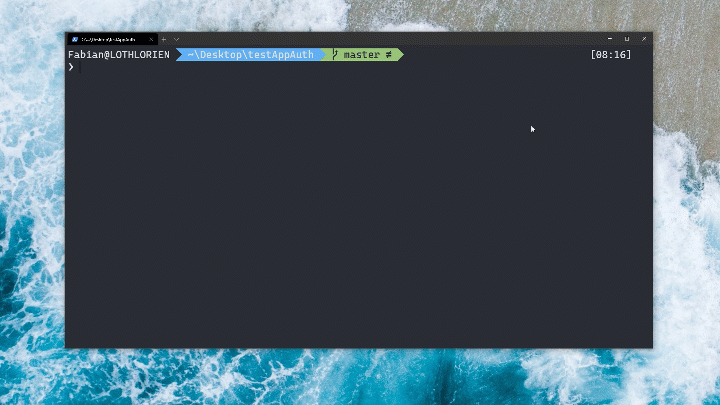 angular-auth-oidc-client
angular-auth-oidc-client
npm package for OpenID Connect, OAuth Code Flow with PKCE, Refresh tokens, Implicit Flow
Top Related Projects
OpenID Connect (OIDC) and OAuth2 protocol support for browser-based JavaScript applications
Support for OAuth 2 and OpenId Connect (OIDC) in Angular.
OpenID Connect (OIDC) and OAuth2 protocol support for browser-based JavaScript applications
JavaScript client SDK for communicating with OAuth 2.0 and OpenID Connect providers.
OAuth 2 / OpenID Connect Client API for JavaScript Runtimes
Quick Overview
Angular-auth-oidc-client is an OpenID Connect (OIDC) and OAuth2 library for Angular applications. It provides a robust implementation for authentication and authorization, supporting various OIDC and OAuth2 flows, including implicit flow and code flow with PKCE.
Pros
- Easy integration with Angular applications
- Supports multiple OIDC providers and configurations
- Implements security best practices, including PKCE
- Actively maintained with regular updates
Cons
- Steep learning curve for developers new to OIDC concepts
- Limited documentation for advanced use cases
- Potential performance impact on larger applications
- Some users report occasional issues with token refresh
Code Examples
- Basic configuration:
import { AuthModule } from 'angular-auth-oidc-client';
@NgModule({
imports: [
AuthModule.forRoot({
config: {
authority: 'https://your-authority.com',
redirectUrl: window.location.origin,
clientId: 'your-client-id',
scope: 'openid profile email',
responseType: 'code',
},
}),
],
})
export class AppModule {}
- Checking authentication status:
import { OidcSecurityService } from 'angular-auth-oidc-client';
export class AppComponent {
constructor(public oidcSecurityService: OidcSecurityService) {}
ngOnInit() {
this.oidcSecurityService.checkAuth().subscribe(({ isAuthenticated }) => {
console.log('App is authenticated', isAuthenticated);
});
}
}
- Initiating login:
import { OidcSecurityService } from 'angular-auth-oidc-client';
export class LoginComponent {
constructor(private oidcSecurityService: OidcSecurityService) {}
login() {
this.oidcSecurityService.authorize();
}
}
Getting Started
-
Install the library:
npm install angular-auth-oidc-client -
Import and configure the
AuthModulein yourapp.module.ts:import { AuthModule } from 'angular-auth-oidc-client'; @NgModule({ imports: [ AuthModule.forRoot({ config: { authority: 'https://your-authority.com', redirectUrl: window.location.origin, clientId: 'your-client-id', scope: 'openid profile email', responseType: 'code', }, }), ], }) export class AppModule {} -
Use the
OidcSecurityServicein your components to handle authentication and authorization.
Competitor Comparisons
OpenID Connect (OIDC) and OAuth2 protocol support for browser-based JavaScript applications
Pros of identity-model-oidc-client-js
- More comprehensive documentation and examples
- Broader browser support, including older versions
- Active community and regular updates
Cons of identity-model-oidc-client-js
- Steeper learning curve for beginners
- Less Angular-specific optimizations
- Larger bundle size due to broader feature set
Code Comparison
angular-auth-oidc-client:
import { AuthModule } from 'angular-auth-oidc-client';
@NgModule({
imports: [
AuthModule.forRoot({
config: { authority: 'https://localhost:5001', redirectUrl: window.location.origin, clientId: 'client' }
})
]
})
identity-model-oidc-client-js:
import { UserManager } from 'oidc-client';
const settings = {
authority: 'https://localhost:5001',
client_id: 'client',
redirect_uri: window.location.origin + '/callback.html',
response_type: 'code',
scope: 'openid profile api'
};
const userManager = new UserManager(settings);
The angular-auth-oidc-client example shows a more Angular-centric approach with module configuration, while identity-model-oidc-client-js demonstrates a more generic JavaScript setup. The latter offers more flexibility but requires additional setup for Angular integration.
Both libraries provide robust OIDC authentication capabilities, with angular-auth-oidc-client being more tailored for Angular applications and identity-model-oidc-client-js offering a more versatile solution for various JavaScript environments.
Support for OAuth 2 and OpenId Connect (OIDC) in Angular.
Pros of angular-oauth2-oidc
- More comprehensive documentation and examples
- Support for multiple OAuth 2.0 flows, including implicit and code flow
- Active community with frequent updates and contributions
Cons of angular-oauth2-oidc
- Slightly more complex setup process
- May have a steeper learning curve for beginners
- Some users report occasional issues with token refresh
Code Comparison
angular-oauth2-oidc:
import { AuthConfig } from 'angular-oauth2-oidc';
export const authConfig: AuthConfig = {
issuer: 'https://idsvr4.azurewebsites.net',
redirectUri: window.location.origin + '/index.html',
clientId: 'spa',
scope: 'openid profile email api',
};
angular-auth-oidc-client:
import { OpenIdConfiguration } from 'angular-auth-oidc-client';
export const config: OpenIdConfiguration = {
authority: 'https://idsvr4.azurewebsites.net',
redirectUrl: window.location.origin,
clientId: 'spa',
scope: 'openid profile email api',
};
Both libraries offer similar functionality for implementing OAuth 2.0 and OpenID Connect in Angular applications. angular-oauth2-oidc provides more extensive documentation and supports multiple OAuth flows, making it suitable for complex scenarios. However, it may be slightly more challenging to set up initially. angular-auth-oidc-client offers a simpler setup process and may be more suitable for beginners or straightforward authentication requirements. The code comparison shows that both libraries use similar configuration objects, with minor differences in property names.
OpenID Connect (OIDC) and OAuth2 protocol support for browser-based JavaScript applications
Pros of oidc-client-ts
- Framework-agnostic, can be used with any JavaScript framework
- Smaller bundle size, focused solely on OIDC functionality
- More active development and frequent updates
Cons of oidc-client-ts
- Less Angular-specific features and integrations
- May require more manual configuration for Angular projects
- Fewer built-in guards and interceptors for Angular routing
Code Comparison
oidc-client-ts:
import { UserManager } from "oidc-client-ts";
const userManager = new UserManager(settings);
const user = await userManager.signinRedirect();
angular-auth-oidc-client:
import { OidcSecurityService } from 'angular-auth-oidc-client';
constructor(public oidcSecurityService: OidcSecurityService) {}
this.oidcSecurityService.authorize();
The oidc-client-ts library provides a more generic approach, while angular-auth-oidc-client offers Angular-specific implementations. oidc-client-ts requires manual instantiation of the UserManager, whereas angular-auth-oidc-client integrates more seamlessly with Angular's dependency injection system.
Both libraries serve the purpose of implementing OpenID Connect authentication, but they cater to different use cases. oidc-client-ts is more versatile for various JavaScript projects, while angular-auth-oidc-client is tailored specifically for Angular applications, providing a more integrated experience within the Angular ecosystem.
JavaScript client SDK for communicating with OAuth 2.0 and OpenID Connect providers.
Pros of AppAuth-JS
- More lightweight and focused solely on OpenID Connect and OAuth 2.0
- Broader browser and platform support, including mobile browsers
- Implements the AppAuth pattern, which is designed for better security
Cons of AppAuth-JS
- Less Angular-specific features and integration
- May require more manual configuration for Angular projects
- Fewer built-in utilities for token handling and storage
Code Comparison
AppAuth-JS:
const authorizationHandler = new AuthorizationRequestHandler();
authorizationHandler.performAuthorizationRequest(configuration, request);
angular-auth-oidc-client:
this.oidcSecurityService.authorize();
Summary
AppAuth-JS is a more general-purpose library for OpenID Connect and OAuth 2.0, offering broader platform support and implementing the AppAuth security pattern. However, it may require more setup for Angular projects. angular-auth-oidc-client is specifically designed for Angular, providing easier integration and more built-in features for token handling, but with a narrower focus on Angular applications.
OAuth 2 / OpenID Connect Client API for JavaScript Runtimes
Pros of openid-client
- Language-agnostic: Can be used with various programming languages and frameworks
- More comprehensive OpenID Connect support, including advanced features
- Actively maintained with frequent updates and improvements
Cons of openid-client
- Steeper learning curve due to its broader scope and flexibility
- Less Angular-specific optimizations and integrations
- May require additional configuration for Angular projects
Code Comparison
angular-auth-oidc-client:
import { AuthModule } from 'angular-auth-oidc-client';
@NgModule({
imports: [AuthModule.forRoot({
config: { authority: 'https://example.com', clientId: 'client' }
})]
})
export class AppModule {}
openid-client:
const { Issuer } = require('openid-client');
Issuer.discover('https://example.com')
.then(issuer => {
const client = new issuer.Client({
client_id: 'client',
client_secret: 'secret'
});
});
The angular-auth-oidc-client example shows a more Angular-specific implementation, while openid-client demonstrates a more generic approach that can be adapted to various environments. The openid-client example requires additional setup for Angular integration, but offers more flexibility for different use cases.
Convert  designs to code with AI
designs to code with AI

Introducing Visual Copilot: A new AI model to turn Figma designs to high quality code using your components.
Try Visual CopilotREADME
Angular Lib for OpenID Connect & OAuth2
Secure your Angular app using the latest standards for OpenID Connect & OAuth2. Provides support for token refresh, all modern OIDC Identity Providers and more.
Acknowledgements
This library is certified by OpenID Foundation. (RP Implicit and Config RP)
Features
- Code samples for most of the common use cases
- Supports schematics via
ng addsupport - Supports all modern OIDC identity providers
- Supports OpenID Connect Code Flow with PKCE
- Supports Code Flow PKCE with Refresh tokens
- Supports OpenID Connect Implicit Flow
- Supports OpenID Connect Session Management 1.0
- Supports RFC7009 - OAuth 2.0 Token Revocation
- Supports RFC7636 - Proof Key for Code Exchange (PKCE)
- Supports OAuth 2.0 Pushed authorisation requests (PAR) draft
- Semantic releases
- Github actions
- Modern coding guidelines with prettier, husky
- Up to date documentation
- Implements OIDC validation as specified, complete client side validation for REQUIRED features
- Supports authentication using redirect or popup
Installation
Ng Add
You can use the schematics and ng add the library.
ng add angular-auth-oidc-client
And answer the questions. A module will be created which encapsulates your configuration.

Npm / Yarn
Navigate to the level of your package.json and type
npm install angular-auth-oidc-client
or with yarn
yarn add angular-auth-oidc-client
Documentation
Samples
Quickstart
For the example of the Code Flow. For further examples please check the Samples Section.
If you have done the installation with the schematics, these modules and files should be available already!
Configuration
Import the AuthModule in your module.
import { NgModule } from '@angular/core';
import { AuthModule, LogLevel } from 'angular-auth-oidc-client';
// ...
@NgModule({
// ...
imports: [
// ...
AuthModule.forRoot({
config: {
authority: '<your authority address here>',
redirectUrl: window.location.origin,
postLogoutRedirectUri: window.location.origin,
clientId: '<your clientId>',
scope: 'openid profile email offline_access',
responseType: 'code',
silentRenew: true,
useRefreshToken: true,
logLevel: LogLevel.Debug,
},
}),
],
// ...
})
export class AppModule {}
And call the method checkAuth() from your app.component.ts. The method checkAuth() is needed to process the redirect from your Security Token Service and set the correct states. This method must be used to ensure the correct functioning of the library.
import { Component, OnInit, inject } from '@angular/core';
import { OidcSecurityService } from 'angular-auth-oidc-client';
@Component({
/*...*/
})
export class AppComponent implements OnInit {
private readonly oidcSecurityService = inject(OidcSecurityService);
ngOnInit() {
this.oidcSecurityService
.checkAuth()
.subscribe((loginResponse: LoginResponse) => {
const { isAuthenticated, userData, accessToken, idToken, configId } =
loginResponse;
/*...*/
});
}
login() {
this.oidcSecurityService.authorize();
}
logout() {
this.oidcSecurityService
.logoff()
.subscribe((result) => console.log(result));
}
}
Using the access token
You can get the access token by calling the method getAccessToken() on the OidcSecurityService
const token = this.oidcSecurityService.getAccessToken().subscribe(...);
And then you can use it in the HttpHeaders
import { HttpHeaders } from '@angular/common/http';
const token = this.oidcSecurityServices.getAccessToken().subscribe((token) => {
const httpOptions = {
headers: new HttpHeaders({
Authorization: 'Bearer ' + token,
}),
};
});
You can use the built in interceptor to add the accesstokens to your request
AuthModule.forRoot({
config: {
// ...
secureRoutes: ['https://my-secure-url.com/', 'https://my-second-secure-url.com/'],
},
}),
providers: [
{ provide: HTTP_INTERCEPTORS, useClass: AuthInterceptor, multi: true },
],
Versions
Current Version is Version 19.x
- Info about Version 18
- Info about Version 17
- Info about Version 16
- Info about Version 15
- Info about Version 14
- Info about Version 13
- Info about Version 12
- Info about Version 11
- Info about Version 10
License
Authors
Top Related Projects
OpenID Connect (OIDC) and OAuth2 protocol support for browser-based JavaScript applications
Support for OAuth 2 and OpenId Connect (OIDC) in Angular.
OpenID Connect (OIDC) and OAuth2 protocol support for browser-based JavaScript applications
JavaScript client SDK for communicating with OAuth 2.0 and OpenID Connect providers.
OAuth 2 / OpenID Connect Client API for JavaScript Runtimes
Convert  designs to code with AI
designs to code with AI

Introducing Visual Copilot: A new AI model to turn Figma designs to high quality code using your components.
Try Visual Copilot




